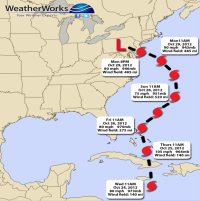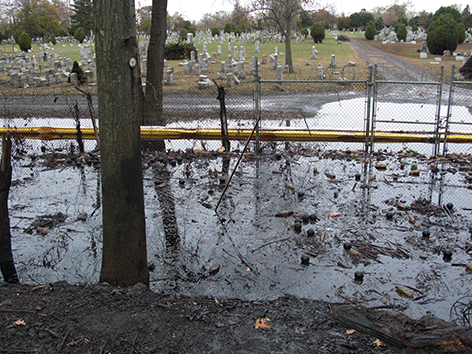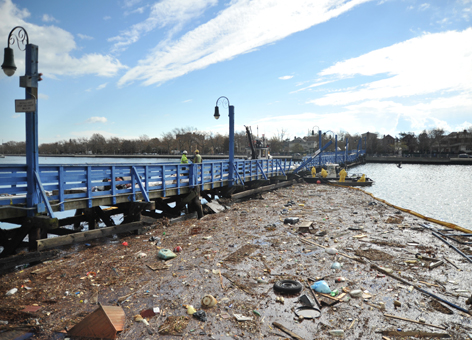The Hidden Damage of Coastal Storms

Irene Targeted 10% of the Nation’s Refining Capacity
When Hurricane Irene headed north late in the Summer of 2011, there was a lot of talk about the effect the storm would have on the nation’s gas prices. Irene’s track put 10% of the country’s refining capacity directly in the bulls eye as the category 2 hurricane steamrolled towards landfall on the New Jersey coast. Disruption of gasoline production at refineries in Delaware, Pennsylvania and New Jersey was a major concern. Irene turned out to be more of a rain-maker for the mid-Atlantic region with modest winds and a storm surge between 6 and 8 feet. While the storm produced record inland flooding resulting from rainfall of up to 15 inches, much of the oil industry’s infrastructure in coastal locations was spared.
The economic damage and turmoil that coastal storms can cause are certainly noteworthy, however, temporary interference with gasoline production is a minor concern compared with the more lasting impacts of severe weather hitting our nation’s industrial production centers. The combination of a changing climate and rising sea-levels is creating the potential for a public health disaster anywhere a tropical cyclone or nor’easter affects the U.S. coastline from Texas to Maine. While the aftermath of Japan’s Fukushima disaster makes headlines and raises fears of a similar incident here in the U.S., a much different, but still highly dangerous, threat lurks below the radar. Oil refineries and petrol-chemical facilities dot the coast along this stretch. The anticipated onslaught of more frequent and more severe storms superimposed upon a higher base sea level places these installations at ever increasing risks of flooding. But the real damage isn’t to the economy or the infrastructure itself, it is to the environment and the population living in proximity to these locations. Additionally, a disproportionate number of the people living in these areas are economically disadvantaged raising issues of environmental justice.

Sandy Headed Right for the Oil Refineries of the Mid-Atlantic
When Hurricane Sandy made landfall in New Jersey, a little over a year after Irene, it brought a storm surge of up to 16 feet to the New York metropolitan area. Unlike Irene, Sandy inundated refineries and chemical plants in New Jersey. There were an estimated 630 storm-related oil spills in New York City. However, New Jersey took the worst blow regarding oil contamination after a significant diesel fuel spill at the Motiva Refinery into the Arthur Kill. According to New Jersey environmental officials, 336,000 gallons of diesel fuel spilled into the waterway after a storage tank ruptured from the storm surge. Major sewage treatment plants were disabled resulting in the discharge of an estimated 11 billion pounds of untreated effluent into the harbor and surrounding tidal rivers and bays. As the floodwaters spread inland, they carried large amounts of chemicals and petroleum products with them. When they receded they left behind a toxic residue that covered the ground, coated homes, and fouled the region’s wetlands and waterways.
In Newark’s Ironbound neighborhood, an area of the city that hosts both industrial plants and a vibrant and ethnically diverse residential community, Sandy’s storm surge pushed the waters of Newark Bay and the Passaic River into areas that had never experienced tidal flooding before. The water carried, not only highly contaminated sediments from these waterways, but chemicals from Superfund sites and industrial plants located along the shoreline. Compounding this, the Passaic Valley Sewage Commission’s main treatment facility, the nearby Newark Bay Pumping Station that handles sewer effluent for much of northern New Jersey, was shut down after being overwhelmed by the storm’s tidal surge.This resulted in 3.1 billion gallons of untreated sewage being released into the water. This noxious brew poured into basements, homes and businesses.
Water and air, the two essential fluids on which all life depends, have become global garbage cans.- Jacques Cousteau

Sandy’s Flood Waters Left Behind A Toxic Residue
Following the storm, once the flooding had receded, people were cleaning, trying to get back into their homes, unaware that there was much more left behind than just water. Information on what people were being exposed to was very difficult to come by. New Jersey’s environmental agency, the Department of Environmental Protection, provided little or no information to residents. Meanwhile, folks were pumping water and cleaning muck that was laden with PCB’s, Dioxin and the residue of raw sewage including high levels of E.Coli and coliform bacteria. Similar issues arose in Louisiana in 2005 following Hurricane Katrina. Just as in Sandy, oil refineries, petrol-chemical installations and Superfund sites were flooded. Sewage treatment plants were knocked off-line and flooding was not just flooding. The damage to the environment and the threat to public health were not immediately recognized and under-reported until well after the storm and people had already been exposed. The National Academy of Engineering released a report in 2006 detailing many of the issues that arose.
The USGS is sampling water in Hurricane Sandy’s aftermath to develop an understanding of the changes in water quality across impacted regions. Contaminants such as pesticides and E. coli in water affect both human and wildlife health. On a longer time scale, excessive nutrients introduced to waterways by increased runoff from the land due to Hurricane Sandy has the potential to cause algal blooms across the region leading to the degradation of ecosystems and increased costs to treat drinking water. Lower oxygen levels caused by bio-degradation of petroleum products can lead to fish kills. There is also the potential for many of these contaminants to become caught up in the food chain. The New York Harbor region is a rich nursery for fish, shellfish and migratory birds and there is a strong likelihood that they will persist in the ecosystem for years. Many of these effects were observed in the Gulf Coast region following Katrina and are likely to be found in the mid-Atlantic now.

What A Mess
The real questions, however, aren’t about what happened. The important issue is what are we going to do to avoid a repeat of these conditions. Storms like Katrina and Sandy are going to happen again. With higher sea levels, even lesser storms may create similar conditions. The next one may make landfall in the Chesapeake region or perhaps along the New England coast. Wherever it may be, there will be sewage treatment plants, industrial facilities and contaminated sites in vulnerable locations. So, while a temporary spike in gas prices will dominate the news in advance of an impending storm, there are much higher costs to be paid in terms of public health and environmental damage.
We can’t make the argument that we didn’t know what could happen. We go to great lengths to protect against industrial accidents or terrorist attacks at many of these facilities. Yet we do little, if anything, to reduce or avoid vulnerability to the much more likely threats of extreme weather events. Requiring refineries and treatment plants to be retro-fitted and hardened against flooding hazards, putting stronger building codes for these installations in place or even moving them out of harm’s way is a relatively minor investment compared with the potential damage that will result from a failure to act. Further, these are not theoretical or perceived dangers. Something like this will occur again. We need to overcome our reticence to invest in infrastructure and prevention (and a significant portion of Sandy recovery money must be spent towards this end) because there is a much higher cost that will result from inaction. -Ben Spinelli
And oh yeah-don’t forget to listen to this!